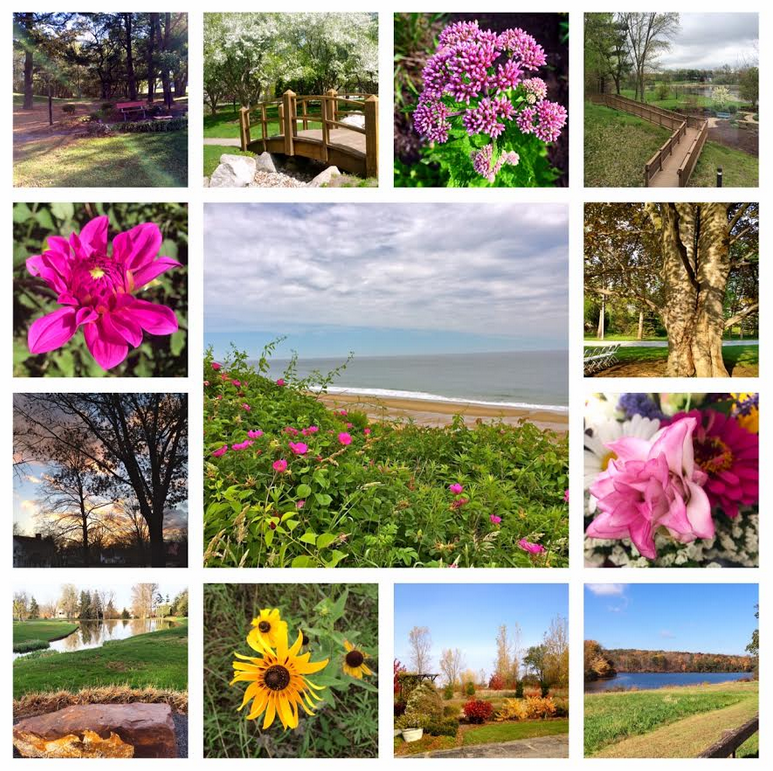Glimpses of Healing and Hope

Have you experienced sacred space or thin places in nature?
July 31, 2017
By Jane Bishop Halteman
Themes from Kern Road's current intergenerational formation class entitled Worshiping God through Creation have taken me back to my first brush with Celtic spirituality in late 2000 after delivering daughter Megan to Belfast for a nine-month stint with Mennonite Mission Network.
Reading all that I could get my hands on about Celtic spirituality back then after a stimulating 10 days in Northern Ireland, I devoured books including Michael Mitton’s The Soul of Celtic Spirituality, with some familiar chapter headings like The Preeminence of the Bible, The Celtic Commitment of Community, and The Mission of Evangelism along side the unfamiliar Love of God’s Creation. I was astounded to learn from J. Philip Newell’s Listening for the Heartbeat of God that the author could identify Celtic spirituality roots in the New Testament in the mysticism of St. John the Evangelist.
Later I would become aware of Margaret Silf’s Sacred Spaces which delves into the spiritual insights to be learned from such sacred spaces as hilltops, wells, and groves/springs. I found it all utterly fascinating and unlike anything I had learned in my growing up years. Always a lover of nature, I had feared as a youngster the Pelagian heresy of loving creation too much; it was comforting to learn so many years later about the Celtic inclination to love the Creator through appreciation of the Divine's creation.
The jacket of Sacred Spaces notes that “the Celts believed that the visible and invisible worlds, the material and the spiritual, were one. For them, certain places were sacred—places where the divide between visible and invisible was very thin, where the presence of the spiritual was almost palpable. They revered such ‘thin places’ as ‘sacred space.’”
A Spirituality & Practice book review notes that “a thin place could be a conversation, a dream, a room, a tree, a dawn, a shore, a dance, a person, a scientific lab, a Sabbath, a Eucharist,” according to Samir Selmanovic, a self-described Muslim Atheist Jewish Christian and author of It’s Really All about God.
“Once,” Selmanovic reports, “while I was teaching a class at a Christian theological seminary in Michigan, a young woman raised her hand to describe the experience that led her to faith. Years ago, in her room, while working on her computer, she turned to reach for a book, and it happened. She smelled God. That’s what she said. You could almost hear the rest of us in the classroom thinking, ‘Oh, please. It is embarrassing characters like this that tarnish the reputation of Christianity as a respectable religion. Let’s talk about something sane and real.’ But she was sane and real, lucid like the bright icy Michigan day outside of the walls of the Andrews University classroom. At her thin place, she caught a scent of God, and her life took a turn.”
In Selmanovic’s words, “Thin places are stopping places where we, for at least a moment, step into what lies beyond the doorway of the world limited to our five senses. These experiences confirm our hopes and bind us to our beliefs. Two worlds become one.”
Our hilltop experiences, which Silf suggests function as our summits of vision, “expose us to a burst of creative energy capable of fueling the next stage of our onward journey,” but these experiences also “demand of us that we move on, that we walk back down to the valleys of our daily lives, there to live in the power and live out the vision of what we have seen and known at the summit.”
Wells can be pools of possibility or places to be boarded up, according to Silf, who also says that “these wells of our lives may be the very places from which we draw living water.” She goes on to state that wells “enable us to draw life-giving water from the depths of the earth. Our experience goes ‘down’ as well as ‘up.’ Down to the depths of pain and darkness as well as up to the hilltop summits of energy and vision.”
Silf speaks about groves/springs, another of her named sacred spaces, as circles of hospitality: “The gift of our sacred groves is to bind us together into human communities, large and small, and, just as towns and villages evolve around a source of water, or other resources essential to life, so our personal groves evolve around a ‘spring.’”
She explains the spring like this: “Spring water is given to us gratuitously. It bubbles up from the depths of the earth without our doing and supplies energy and life without our asking. It trickles, uninvited, from cracks in the hard rock of our experience. It takes us by surprise, appearing out of nowhere to refresh and encourage us.”
I am certain the connection I feel to Celtic spirituality and practitioners' ability to see God in nature has led to my mindfulness practice of using photography to become more aware of God in God's creation. Check this Glimpses of Healing and Hope post from last summer for more on contemplative photography. The vision of Celtic spirituality to embrace nature as powerful imagery for the faith journey resonates with me, too, as I have experienced not only the bubbling spring water of which Silf speaks, but also the wells of living water and the summits that fuel the next stage of the journey.
Where have you discovered sacred space or thin places in creation? Even from your armchair, you might imagine yourself along a rocky Irish coastline with boisterous waves crashing nearby. Take a moment to let the cares of the day float out to sea as you express gratitude for today’s gifts and open yourself to listening for the voice of the Divine in the beauty of nature that surrounds you.
